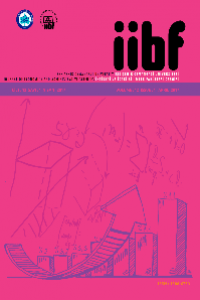Measuring the Real Exchange Rate Misalignment with Behavioral Equilibrium Exchange Rate Approach: The Case of Turkey
Abstract
In this study the real |
Keywords
Behavioral Equilibrium Exchange Rate Model Real Ex-change Rate Misalignment Real Exchange Rate Equilibrium Real Exchange Rate
References
- Clark, P. B. and R. MacDonald (1997), “Exchange Rates And Economic Fundamentals: A Methodological Comparison of BEERS and FEERS”, Ed: R. MacDonald ve J.L. Stein, Equilibrium Exchange Rates, Kluwer Academic Publishers, Londra: Birleşik Krallık.
- Clark, P.B. ve R. MacDonald (1999), “Exchange Rates And Economic Fundamentals: A Methodological Comparison of BEERS and FEERS”, Ed: R. MacDonald ve J.L. Stein, Equilibrium Exchange Rates, Kluwer Academic Publishers, Londra: Birleşik Krallık.
- Clark, P.B. ve R. MacDonald, (1998). “Exchange Rates and Economic Fundamentals: A Methodological Comparison of BEERS and FEERS”, International Monetary Fund Working Paper No. 98/67.
- Clark, P.B. ve R. MacDonald (2000), “Filtering The BEER: A Permanent and Transitory Decomposition”, International Monetary Fund, Working Paper No. 00/144.
- Çulha, O; Çulha, A. ve Gönenç, R. (2008), “The Challenges of Monetary Policy in Turkey”, OECD Economic Department Working Paper No: 646.
- Edwards, S. (1987), “Exchange Rate Misalignment in Developing Countries”, Los Angeles: University of California and National Bureau of Economic Research.
- Edwards, S. (1988), “Real and Monetary Determinants of Real Exchange Rate Behavior”, Journal of Development Economics, 29, 311–341.
- Edwards, S. (1989), “Real Exchange Rates, Devaluation and Adjustment: Exchange Rate Policy in Developing Countries”, Cambridge, Mass and London: MIT Press.
- Edwards, S. (1994), “Real and Monetary Determinants of Real Exchange Rate Behavior: Theory and Evidence From Developing Countires”, Ed: J. Williamson, Estimating Equilibrium Exchange Rates, Washington DC: Institute for International Economics, ss. 61-92.
- Elbadawi, I.A. (1994), “Estimating long-run equilibrium real exchange rates”, Ed: J. Williamson, Estimating equilibrium real exchange rates, Londra: Longman Group Limited.
- MacDonald, R. (2007), “Exchange Rate Economics: Theories and Evidence”, NewYork: Routledge.
- MacDonald, R. ve Dias, P. (2007), “Behavioural Equilibrium Exchange Rate Estimates and Implied Exchange Rate Adjustments for Ten Countries”, Workshop on Global Imbalances, Peterson Institute of International Economics, Washington DC February 2007.
- Özçam, M. (2004), “Döviz Kuru Politikaları ve Türkiye’de Döviz Kuru Oynaklığının Etkileşimleri”, SPK Araştırma Raporu. http://www.spk.gov.tr/yayingoster.aspx?yid=943&ct =f&action=displayfile., (Erişim: 10. 11.2015)
- Pesaran, M. H.; Shin, Y. and Smith, R. J. (2001), “Bounds Testing Approaches to The Analysis of Level Relationships”, Journal of Applied Econometrics, 16, 289–326.
- TCMB, (1998), “Merkez Bankası 1998 Yılı İlk Altı Aylık Para Programı Gerçekleşmesi Ve İkinci Altı Aylık Para Politikası Uygulaması”.
- TCMB, (2001), “Para Politikası Raporu”.
- TCMB, (2009), “2010 Yılında Para ve Kur Politikası”.
- TCMB, (2011), “2012 Yılında Para ve Kur Politikası”.
- TCMB, (2014), “2015 Yılında Para ve Kur Politikası”.
Davranışsal Denge Döviz Kuru Yaklaşımı ile Reel Döviz Kurlarının Yanlış Dengelenmesinin Ölçülmesi: Türkiye Örneği
Abstract
Çalışmada, |
Keywords
Davranışsal Denge Döviz Kuru Modeli Reel Döviz Kurlarının Yanlış Dengelenmesi Reel Döviz Kuru Denge Reel Döviz KuruDenge Reel Döviz Kuru
References
- Clark, P. B. and R. MacDonald (1997), “Exchange Rates And Economic Fundamentals: A Methodological Comparison of BEERS and FEERS”, Ed: R. MacDonald ve J.L. Stein, Equilibrium Exchange Rates, Kluwer Academic Publishers, Londra: Birleşik Krallık.
- Clark, P.B. ve R. MacDonald (1999), “Exchange Rates And Economic Fundamentals: A Methodological Comparison of BEERS and FEERS”, Ed: R. MacDonald ve J.L. Stein, Equilibrium Exchange Rates, Kluwer Academic Publishers, Londra: Birleşik Krallık.
- Clark, P.B. ve R. MacDonald, (1998). “Exchange Rates and Economic Fundamentals: A Methodological Comparison of BEERS and FEERS”, International Monetary Fund Working Paper No. 98/67.
- Clark, P.B. ve R. MacDonald (2000), “Filtering The BEER: A Permanent and Transitory Decomposition”, International Monetary Fund, Working Paper No. 00/144.
- Çulha, O; Çulha, A. ve Gönenç, R. (2008), “The Challenges of Monetary Policy in Turkey”, OECD Economic Department Working Paper No: 646.
- Edwards, S. (1987), “Exchange Rate Misalignment in Developing Countries”, Los Angeles: University of California and National Bureau of Economic Research.
- Edwards, S. (1988), “Real and Monetary Determinants of Real Exchange Rate Behavior”, Journal of Development Economics, 29, 311–341.
- Edwards, S. (1989), “Real Exchange Rates, Devaluation and Adjustment: Exchange Rate Policy in Developing Countries”, Cambridge, Mass and London: MIT Press.
- Edwards, S. (1994), “Real and Monetary Determinants of Real Exchange Rate Behavior: Theory and Evidence From Developing Countires”, Ed: J. Williamson, Estimating Equilibrium Exchange Rates, Washington DC: Institute for International Economics, ss. 61-92.
- Elbadawi, I.A. (1994), “Estimating long-run equilibrium real exchange rates”, Ed: J. Williamson, Estimating equilibrium real exchange rates, Londra: Longman Group Limited.
- MacDonald, R. (2007), “Exchange Rate Economics: Theories and Evidence”, NewYork: Routledge.
- MacDonald, R. ve Dias, P. (2007), “Behavioural Equilibrium Exchange Rate Estimates and Implied Exchange Rate Adjustments for Ten Countries”, Workshop on Global Imbalances, Peterson Institute of International Economics, Washington DC February 2007.
- Özçam, M. (2004), “Döviz Kuru Politikaları ve Türkiye’de Döviz Kuru Oynaklığının Etkileşimleri”, SPK Araştırma Raporu. http://www.spk.gov.tr/yayingoster.aspx?yid=943&ct =f&action=displayfile., (Erişim: 10. 11.2015)
- Pesaran, M. H.; Shin, Y. and Smith, R. J. (2001), “Bounds Testing Approaches to The Analysis of Level Relationships”, Journal of Applied Econometrics, 16, 289–326.
- TCMB, (1998), “Merkez Bankası 1998 Yılı İlk Altı Aylık Para Programı Gerçekleşmesi Ve İkinci Altı Aylık Para Politikası Uygulaması”.
- TCMB, (2001), “Para Politikası Raporu”.
- TCMB, (2009), “2010 Yılında Para ve Kur Politikası”.
- TCMB, (2011), “2012 Yılında Para ve Kur Politikası”.
- TCMB, (2014), “2015 Yılında Para ve Kur Politikası”.
Details
| Journal Section | Articles |
|---|---|
| Authors | |
| Publication Date | August 1, 2017 |
| Submission Date | July 8, 2017 |
| Published in Issue | Year 2017 Volume: 12 Issue: 2 |


